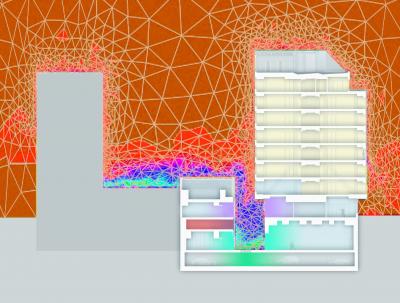Oct 16 2012
Researchers from the University of Seville (Spain) have used mathematical tools to assess what has been known for centuries: the temperature inside the typical Mediterranean courtyard is cooler than that of the street. Though seemingly common sense, understanding such information in detail helps to save energy and money, which is the objective of eco-efficient buildings.
 The researcher's model has been put to the test in a hotel in Malaga (credit: Arquitectos Hombre de Piedra)
The researcher's model has been put to the test in a hotel in Malaga (credit: Arquitectos Hombre de Piedra)
The inhabitants of Mediterranean regions have known for centuries that during the summer their courtyards are cooler than the street. "Why then put air conditioning extractor units on rooftops or outer walls when we could save energy by taking the cooler air from inside the courtyard," suggests architect Juan Manuel Rojas.
Along with two lecturers at the University of Seville, the researcher has developed a mathematical tool that for the first time assesses the complex thermodynamic behaviour of the courtyard. Details have been published in the Energies journal.
"These spaces create a mixture of phenomena: stratification (hot air rises and cold air falls); convection (the walls heated throughout the day project air upwards); and flow patterns (whirlwind formation depending on the geometry of the space)," explains Rojas.
All of this information is brought together in a programme using specific data on the local climate (average temperatures and wind speed) and that of the courtyard itself (height, width, the materials with which it was built) since not all absorb the same levels of radiation. The result is a 'film' showing air evolution throughout the day.
"The model allows for the thermal advantages of the courtyards to be assessed. In turn this provides new design possibilities for more efficient and sustainable buildings without going over budget," outlines the architect, who demands that the knowledge and wisdom used for over 4000 years continues in the construction of modern day buildings.
Eco-efficient projects of recent decades tend to do away with courtyards or use glass covered atriums since the greater the surface area, the greater the energy transmission.
"But the energy rating used to calculate this assumes that the air inside and outside of the courtyard is the same temperature. This is not the case and must be considered," insists Rojas, who recognises that closed atriums can work well in Central and Northern Europe.
The researcher's model has been successfully put to the test in a hotel in Malaga (Monte Málaga) following the thermodynamic strategies of the courtyard for an overall improvement in their energy efficiency.
The hotel is air-conditioned by taking the air from the lower part of the courtyard, which can be up to 9 ºC cooler than outside in the summer. This translates as a financial and energy saving, as the building consumes half the energy of the surrounding buildings.
New historical vision
The study also offers a new thermodynamic interpretation of historical courtyards ranging from traditional examples in Cadiz and Seville to cloisters of Santiago de Compostela Cathedral and the Palazzo Farnese in Rome.
"The deepest and narrowest courtyards work better in hotter regions, whereas more open ones work better in the North, as we can see by simply searching on Google Maps," says Rojas.
The architect believes that the climate, and not culture or art, has conditioned the most appropriate courtyard type according to region, which has then been continued due to tradition: "In the same way that natural selection chooses the best organisms, the area itself has always determined the use of architectural options that have best exploited available resources."